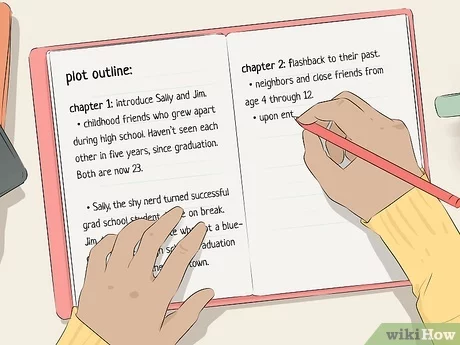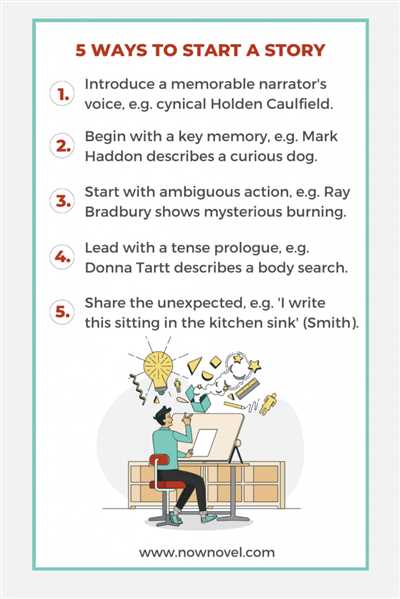
Starting a story is like entering a vast cloud of unpredictable possibilities. You have an idea, characters waiting to be brought to life, and a burning desire to create something good. But where do you start? How do you hook your readers and keep them engaged from the very first line?
One of the best ways to get your story off the ground is to analyze the openings of other great works. Whether it’s Vladimir Nabokov’s “Lolita” or J.D. Salinger’s “The Catcher in the Rye,” there are always lessons to be learned. By studying these openings, you could unlock the key to creating a functional and captivating introduction.
However, keep in mind that there is no one-size-fits-all formula for a good story intro. It all depends on the story you’re telling and the world you’re building. Sometimes, a simple and direct approach works wonders. Other times, a bit of confusion or an initial problem can do the trick. The key is to find a unique line that grabs your reader’s attention and makes them want to keep reading.
If you’re struggling to come up with a great opening, here are 10 tips to help jumpstart your creativity:
- Start with a compelling character. Introduce someone your readers will care about right from the start.
- Open with a vivid description of the setting. Transport your readers to a world they can visualize.
- Create a sense of mystery or suspense. Give your readers a reason to keep turning the pages.
- Begin with an interesting problem or conflict. Show your readers that your story is worth their time.
- Use a memorable quote or dialogue. Start with words that will linger in your readers’ minds.
- Start in the middle of the action. Drop your readers right into the heart of the story.
- Ask a thought-provoking question. Make your readers think and wonder about the answer.
- Introduce a surprising twist or unexpected event. Shock your readers and make them eager to know what happens next.
- Begin with a line that foreshadows the essence of your story. Give your readers a taste of what’s to come.
- Create an emotional connection. Make your readers feel something from the very first sentence.
Remember, the opening of your story matters. It sets the tone for the entire experience and helps your readers decide whether to continue or move on. So don’t waste any more time staring at a blank page. Start writing! You never know where your story could take you.
How to Start a Story
From The World’s Best-Loved Creative Writing School
Starting a story can be both exciting and intimidating. The opening lines are the first impression you make on your readers, so it’s important to get them right. Whether you’re an experienced writer or just starting out, these tips from the world’s best-loved creative writing school can help you create a memorable and unique introduction.
 | 1. Don’t worry about being perfect right away: When starting a story, it’s easy to get caught up in the pressure of writing a perfect opening line. But remember, your opening doesn’t have to be flawless from the start. Just focus on getting your ideas down on paper, and you can always revise and improve later. |
2. Start with a strong narrator-protagonist:
A great way to grab your readers’ attention is to introduce them to a unique and compelling character right from the start. Think about memorable narrators like Vladimir Nabokov’s Humbert Humbert in “Lolita” or J.D. Salinger’s Holden Caulfield in “The Catcher in the Rye.” A strong and interesting narrator can help hook your readers and keep them engaged.
3. Build a world:
Another effective way to start a story is by creating a vivid and immersive world for your readers to delve into. Give them a sense of place and time, and let them feel like they are stepping into a whole new reality. Whether you’re writing about a small town or a sprawling fantasy realm, building a rich and detailed world can captivate your audience right from the beginning.
4. Engage the senses:
When starting your story, don’t just focus on describing what your characters see. Also, think about how they feel, what they hear, and even what they taste and smell. Engaging the senses can help bring your story to life and make it more relatable and immersive for your readers.
5. Create confusion:
A clever technique to grab your readers’ attention is by starting with a bit of confusion or mystery. Raise questions in their minds, make them curious about what’s going on, and keep them turning the pages to find out the answers. Just make sure to eventually provide satisfying explanations to avoid frustrating your audience.
Starting a story can be a daunting task, but with the right approach, you can captivate your readers from the very first line. Remember, it’s not about being perfect right away, but about creating a strong and intriguing start that makes readers eager to delve further into your work. So don’t be afraid to experiment and find the opening that works best for your story. Happy writing!
Introduce readers to a memorable narrator-protagonist

One of the best ways to hook readers from the start of your story is to introduce them to a memorable narrator-protagonist. The narrator-protagonist is the character who tells the story, and their unique perspective can draw readers in and keep them engaged throughout the entire narrative.
When introducing your memorable narrator-protagonist, it’s important to give readers a good sense of who they are and what makes them stand out. This could be through their thoughts, actions, or even their distinctive voice. By giving your readers a strong introduction to the narrator-protagonist, you can set the stage for an immersive reading experience.
One way to make your narrator-protagonist memorable is by showing their flaws and struggles. Characters who have to overcome problems and face adversity are often more relatable and interesting to readers. Whether your narrator-protagonist is dealing with a personal conflict, navigating a complicated relationship, or trying to solve a larger problem within their world, their journey can provide a captivating starting point for your story.
Another important aspect to consider when introducing your narrator-protagonist is their voice. The way they speak and think can help create a strong sense of their personality and add depth to the story. Whether they have a sarcastic sense of humor, a poetic way of describing the world around them, or a unique way of seeing things, their voice can make them more memorable to readers.
One great example of a memorable narrator-protagonist is Holden Caulfield from J.D. Salinger’s “The Catcher in the Rye.” Holden’s distinct voice and witty observations about the hypocrisy and confusion of the adult world have made him one of literature’s most beloved characters. From the first line of the novel, Holden’s voice hooks readers and keeps them invested in his story.
In conclusion, introducing readers to a memorable narrator-protagonist is a great way to start your story. By giving your readers a strong sense of who they are, what struggles they face, and how they see the world, you can capture their attention from the very beginning. So, take the time to develop a unique and compelling narrator-protagonist and watch as your readers become hooked on their story.
8 Good Ways to Start a Story

Starting a story can be a daunting task. You want to captivate your readers right from the beginning and keep them hooked until the end. Whether you are writing a novel, a short story, or a blog post, the opening lines are crucial in grabbing the readers’ attention. Here are 8 good ways to start a story:
1. Start with a unique character
Introduce your readers to a memorable and relatable character right from the beginning. Whether it’s a hero or a villain, a well-developed character can instantly engage readers and make them want to know more about their story.
2. Begin with an intriguing problem
Grab your readers’ attention by starting your story with a problem or conflict. This creates curiosity and makes readers eager to find out how the problem will be resolved.
3. Dive into an action-packed opening
Start your story with a thrilling action sequence that immediately immerses the readers into the world you’ve created. This helps to build excitement and intrigue right from the start.
4. Set the scene with vivid descriptions
Transport your readers to different worlds or locations with rich and detailed descriptions. This helps them to visualize the setting of your story and creates a sense of atmosphere.
5. Begin with a thought-provoking quote or statement
Open your story with a powerful quote or a thought-provoking statement that immediately captures your readers’ attention. This can make them curious about what follows.
6. Start with a personal experience or anecdote
Share a personal experience or an anecdote that relates to the theme or topic of your story. This creates a connection with your readers and makes them feel more engaged.
7. Use a creative hook or a surprise twist
Catch your readers off guard by starting your story with a creative hook or a surprising twist. This can create curiosity and make readers want to keep reading to find out more.
8. Begin with a rhetorical question
Pose a thought-provoking question to your readers that instantly engages them. This can create curiosity and encourage readers to think about the topic or theme of your story.
Remember, a good start sets the tone for the rest of your story. Experiment with these tips and find what works best for your writing style and the story you want to tell. Just keep in mind that the opening lines are your chance to hook your readers and make them want to keep reading.
10 Don’t worry about wasted time
There’s an old saying that goes, “There are no wasted words in a writer’s world.” Every minute you spend writing is valuable, whether it’s producing a best-loved novel or just jotting down ideas in a notebook. Writing helps to flex your creative muscles, exercise your brain, and refine your skills. It’s all part of the journey.
Take J.D. Salinger, for example. He spent years working on “The Catcher in the Rye” before it was published. During that time, he wrote and discarded numerous openings, characters, and story ideas. But those discarded pieces weren’t wasted. They were stepping stones on the path to creating a masterpiece.
Being open to exploration and experimentation is crucial in the writing process. You never know when an idea or character from a previous project will find its way into a new story. That character you thought didn’t fit into one tale could become the narrator-protagonist of another.
Don’t get discouraged if your initial attempts don’t quite hit the mark. Writing requires patience and perseverance. It’s all about trial and error, learning from your mistakes, and refining your craft over time. Those “wasted” moments can often lead to unexpected breakthroughs.
Additionally, the internet is a treasure trove of resources that can help you on your writing journey. Tools like Hotjar and Google Analytics can provide you with valuable data and insights on how users interact with your website, which can in turn help you tailor your writing to your audience and improve the overall experience.
So, don’t fret over wasted time. Embrace it as part of the writing process. Each moment spent writing, brainstorming, and experimenting brings you one step closer to creating something truly unique and meaningful. And remember, sometimes the best stories come from unexpected places.









